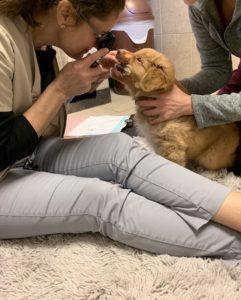Why Your Dog Deserves a Certified Trainer
Every couple of weeks I see another story involving a dog that has been harmed or even worse, lost it’s life in the name of training. Typically these dogs have been sent away for a “bootcamp” that involved staying with the trainer full time. The dogs come back emaciated, wounds around the neck, sick, weak, and in the worst cases they are deceased. The owners are always surprised and why wouldn’t they be? No one willingly sends their dog away thinking it’s going to be harmed. Sadly when I hear these stories I’m no longer surprised and one look at the trainer’s information or website and I can see all the red flags.
My position is a hard one. As a professional trainer if I say something or give warning when I hear someone is considering a boot camp for their dog, it’s sour grapes because the other trainer is competition or I’m biased because it’s a training method argument. Neither of which is true. I’m truly concerned for the well being of the dog and the owner. These boot camps are expensive and sadly the damage that happens in these facilities is going to cost more money to fix and in some cases they can’t be fixed.
What Kind of Help Do You Need
Understanding the difference between training and behavior modification is crucial when choosing a trainer. A professional who is skilled in basic obedience training may not have the expertise to handle more serious behavior issues. For behavior modification, it’s often necessary to work with a behavior consultant or behaviorist who has specialized knowledge and experience in this area. Both professionals have credentials you should look for. A behavior consultant is certified through IAABC, the International Association of Animal Behavior Consultants. A behaviorist is either a veterinarian who is boarded in behavior. Read that AGAIN. A VETERINARIAN who is boarded in behavior. A behaviorist can also be what is called a Certified Applied Animal Behaviorist, also called CAAB. Applied animal behaviorists may have a background in fields as diverse as psychology, biology, zoology, veterinary medicine, or animal sciences. You can not be a self proclaimed behaviorist. There are credentials attached to that title.
What is Training?
Dog training typically involves teaching a dog specific skills, such as sit, stay, come, or walking on a leash. Training focuses on reinforcing desirable behaviors and teaching dogs how to respond to cues from their owners. This process is often about communication and ensuring that dogs understand what is expected of them in various situations.
What is Behavior Modification?
Behavior modification deals with changing a dog’s existing emotions about their environment, This process often involves addressing underlying emotional or psychological issues, such as fear, anxiety, aggression, or excessive barking. Behavior modification is more complex than basic training and usually requires a deeper understanding of learning theory.
Example: If a dog shows signs of aggression towards other dogs, behavior modification might involve identifying the root cause of this aggression (such as fear or territoriality) and gradually desensitizing the dog to the triggers that cause this behavior.
Red Flags to Watch For
Be critical of trainers who guarantee results within a very short time frame. Such promises often indicate the use of aggressive or aversive techniques, which can harm your dog physically and emotionally. Instead, look for trainers who emphasize the importance of ongoing training, gradual progress, and the development of a positive relationship with your dog as well as addressing any physical or possible medical conditions that may contribute to their behavior issues.
The Dangers of Unqualified Trainers
Unqualified trainers use outdated or harmful methods that can lead to behavior issues or even physical harm. The American Veterinary Society of Animal Behavior has very specific position statements on methods of training and the use of correction collars and tools that are used to suppress or correct behavior. Using labels like “dominant”, “pack leader”, “stubborn”, and “respect” are all terms that should raise red flags.
How to Choose the Right Trainer
When selecting a dog trainer, look for certifications from reputable organizations, ask about their training methodology. A good trainer will be transparent about their methods and willing to answer any questions you may have. The right trainer abides by a code of ethics that you can read and obtain upon request. Many are available on the organizations websites. The right trainer attends and seeks out continuing education in canine learning theory that is presented with a scientific approach.
What are the reputable organizations
A certified dog trainer has undergone some sort of evaluation in either skills, knowledge or both and has demonstrated a deep understanding of dog behavior, training techniques, and humane practices. Certification bodies like the Certification Council of Professional Dog Trainers (CCPDT) or the International Association of Animal Behavior Consultants (IAABC) ensure that trainers meet high standards and are committed to continuous education. Other reputable courses and certification are Karen Pryor Academy (KPA), Victoria Silwell Dog Training Academy (VSDTA), and Learning and Living with Animals (LLWA). Professional organizations such as Association of Professional Dog Trainers (APDT) and Pet Professional Guild (PPG) are other good indicators your trainer upholds a high standard of care.
Conclusion: Patience, Persistence, and the Path to a Well-Trained Dog
In dog training, there are no shortcuts. Avoid the allure of quick fixes and remember that meaningful change takes time. Setting realistic expectations for your dog’s skills and behavior is essential for long-term success. By choosing a qualified, ethical trainer and committing to a steady, patient approach, you’ll not only guide your dog toward better behavior but also strengthen the bond you share. Training is a journey, and with dedication and the right support, you and your dog will enjoy the rewards of a well-behaved and happy life together.

 uction doesn’t actually work. You also have to actually do the work and do the work consistently. This means finding time to work with my dogs consistently. Did the instruction of the trainers I worked with fail? No. Did the methods not work? Don’t know. I never followed through.
uction doesn’t actually work. You also have to actually do the work and do the work consistently. This means finding time to work with my dogs consistently. Did the instruction of the trainers I worked with fail? No. Did the methods not work? Don’t know. I never followed through.
 Most veterinarians understand the importance of having a good trainer as part of their team. Working with a qualified trainer can not only keep dogs in their homes, but they can also help a family choose a new dog. Dog trainers are also a great resource to assist with recovery and healing through the use of mental enrichment while on crate rest or limited activity. We can also help ease the stress of scary vet visits that may keep owners from seeking the medical treatment their dog needs. If I had a chance to to talk with veterinarians, this is the information I would like them to know.
Most veterinarians understand the importance of having a good trainer as part of their team. Working with a qualified trainer can not only keep dogs in their homes, but they can also help a family choose a new dog. Dog trainers are also a great resource to assist with recovery and healing through the use of mental enrichment while on crate rest or limited activity. We can also help ease the stress of scary vet visits that may keep owners from seeking the medical treatment their dog needs. If I had a chance to to talk with veterinarians, this is the information I would like them to know.
